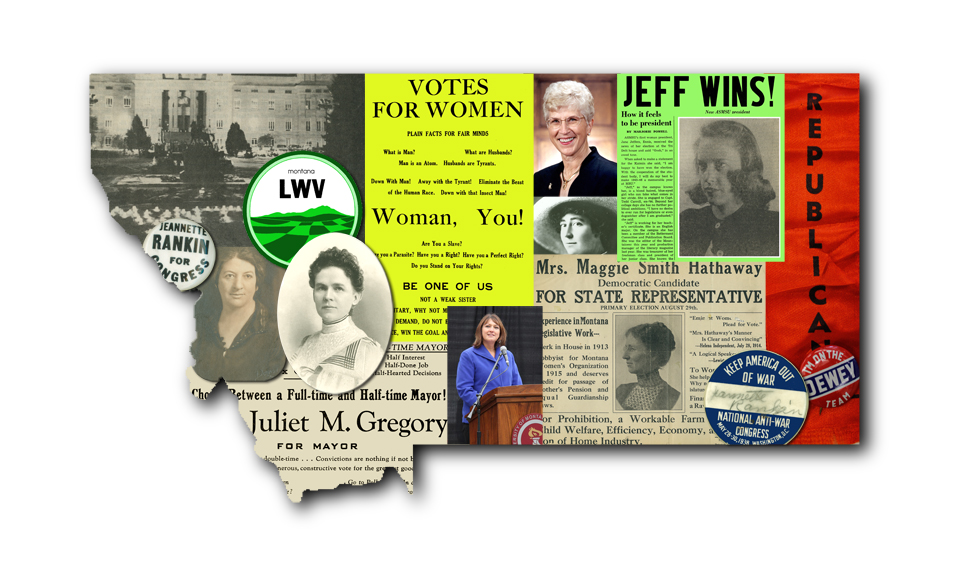- Editorial Offices
- 325 Brantly Hall
- Missoula, MT 59812
- (406) 243-2488
- themontanan@umontana.edu
- Icons By Maria Maldonado

“What is Man?” the flier ponders. “What are Husbands?”
“Man is an Atom,” it answers. “Husbands are Tyrants.”
“Down With Man!” it exclaims. “Away with the Tyrant!”
“Be one of us, not a weak sister!”
The flier, which is chock-full of other racy-for-the-time language, is from September 1914, shellacked and stuffed into a scrapbook kept by Stella Louise Duncan, a Glendive native and student at UM from 1904 to 1907. Her scrapbook now resides inside UM’s Archives & Special Collections at the Mansfield Library.
“You can tell from Stella’s scrapbook that she is really interested in what’s going on in the world around her,” says Carlie Magill ’03, M.A. ’08, an archives specialist.
The flier is especially telling of the time, as women in Montana and across the country were fighting for the right to vote. Just a couple months after Duncan obtained the flier, woman suffrage passed in Montana on November 3, 1914.
“Things like the flier aren’t made to last,” Magill says. “So the fact that she happened to shellac it and save it in her scrapbook is pretty awesome. I’ve done some searching, and I’ve yet to find another one of these. It’s not something that was meant for someone to keep. You were probably supposed to pick it up at a rally and throw it away, but she kept hers.”
A century later, the flier is a focal point of a new exhibit at the library, Women in Montana Politics. It features photographs and documents from well-known early twentieth century suffragists Jeannette Rankin and Ella J. Knowles Haskell, along with information on contemporary activists and politicians such as Juliet Gregory, Missoula’s only female mayor, and Lorena Burgess, a Confederated Salish and Kootenai Tribal Council member.
Magill and fellow Archives Specialist Kellyn Younggren spent nearly three months curating the exhibit, which is featured in display cases on the fourth floor of the library, as well as online. The genesis of the exhibit was to explore woman suffrage in celebration of the centennial but expanded to acknowledge the entirety of women in Montana’s political realm.
While there were many fascinating discoveries in the pair’s search through the archives, there is one woman in particular who is their favorite: Mary Stewart, UM’s first dean of women.
“She comes to UM in 1907 and is quite the rabble-rouser,” Magill says, as if speaking about an old friend. “As the first dean of women, you might think that she just would be making sure all of the girls on campus were in the dorms by their curfew or baking cookies. That was not Mary.”
From what they learned, Stewart was instrumental in organizing suffrage groups on campus and led girls to major rallies at the Wilma Theater, where Rankin spoke.
“She was quite the leader of girls on campus,” Younggren says. “She was interested in getting them politically active. And it showed, because there were these great suffrage groups that grew on campus that really attempted to fight for their rights at UM before they could even vote in the state.
“Mary was very near and dear to us,” she adds.
Another woman whom they found interesting was Florence Leech, a 1912 UM graduate from Valier. Leech, who was called “one of the most capable and most earnest among the women who led Montana’s suffrage campaign” in a December 1914 Montana Kaimin article, was sought by women in New Jersey to help them with their campaign.
“So here is this girl from Montana who graduates and continues to do suffrage-related work clear across the country,” Magill says. “She was sent to New Jersey to rile up the crowds and fight for women. That’s pretty great.”
The flier, Stewart, and Leech are just a sampling of the fascinating history represented in Women in Montana Politics. The exhibit will be on display through September. To learn more, visit the library or go online to http://exhibits.lib.umt.edu/women-in-politics.